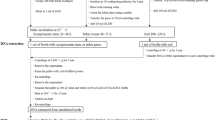Abstract
MOST bacterial plant diseases are caused by bacteria belonging to the genus Pseudomonas. A number of saprophytic pseudomonads occur in large amounts on the surface of the plant (Pseudomonas fluorescens, Ps. denitrificans, etc.). Therefore, isolation of phytopathogenic pseudomonads from the diseased plant is difficult. Generally the morphology of the colonies, the biochemical properties1, the antigenic structure1 and the phage sensitivity2 of the pathogenic and saprophytic pseudomonads are so similar that they can scarcely be distinguished on the basis of the foregoing characteristics. In practice the pathogenicity test is the sole reliable method which can be used for identification. To carry out pathogenicity tests one must have suitable hosts, but in this case the entire procedure of artificial infection in the greenhouse is tedious. Testing of woody plants is particularly difficult.
Similar content being viewed by others
References
Reid, J. J., Naghski, J., Farell, M. A., and Haley, D. E., Pennsylvania Agric. Exp. Sta. Bull., 422 (1942).
Stolp, H., Phytopath. Z., 42, 197 (1961).
Klement, Z., and Lovrekovich, L., Phytopath. Z., 41, 217 (1961).
Klement, Z., and Lovrekovich, L., Phytopath. Z., 45, 81 (1962).
Author information
Authors and Affiliations
Rights and permissions
About this article
Cite this article
KLEMENT, Z. Rapid Detection of the Pathogenicity of Phytopathogenic Pseudomonads. Nature 199, 299–300 (1963). https://doi.org/10.1038/199299b0
Issue Date:
DOI: https://doi.org/10.1038/199299b0
- Springer Nature Limited
This article is cited by
-
Comprehensive genome analysis of Pseudomonas sp. SWRIQ11, a new plant growth-promoting bacterium that alleviates salinity stress in olive
3 Biotech (2023)
-
Bacterial leaf spot and die-back of hazelnut caused by a new pathovar of Pseudomonas amygdali
European Journal of Plant Pathology (2022)
-
Characterization of Pseudomonas cichorii isolated from tomato and lettuce in Iran
Journal of Plant Pathology (2021)
-
Antifungal Activity of Stabilized Ortho Silicic Acid (OSA) against Foliar Plant Pathogens
Silicon (2021)
-
Preliminary characterization and phylogeny of sphingomonads occurring on Stone and Pome Fruit Trees in Northern Iran
Biologia (2021)





